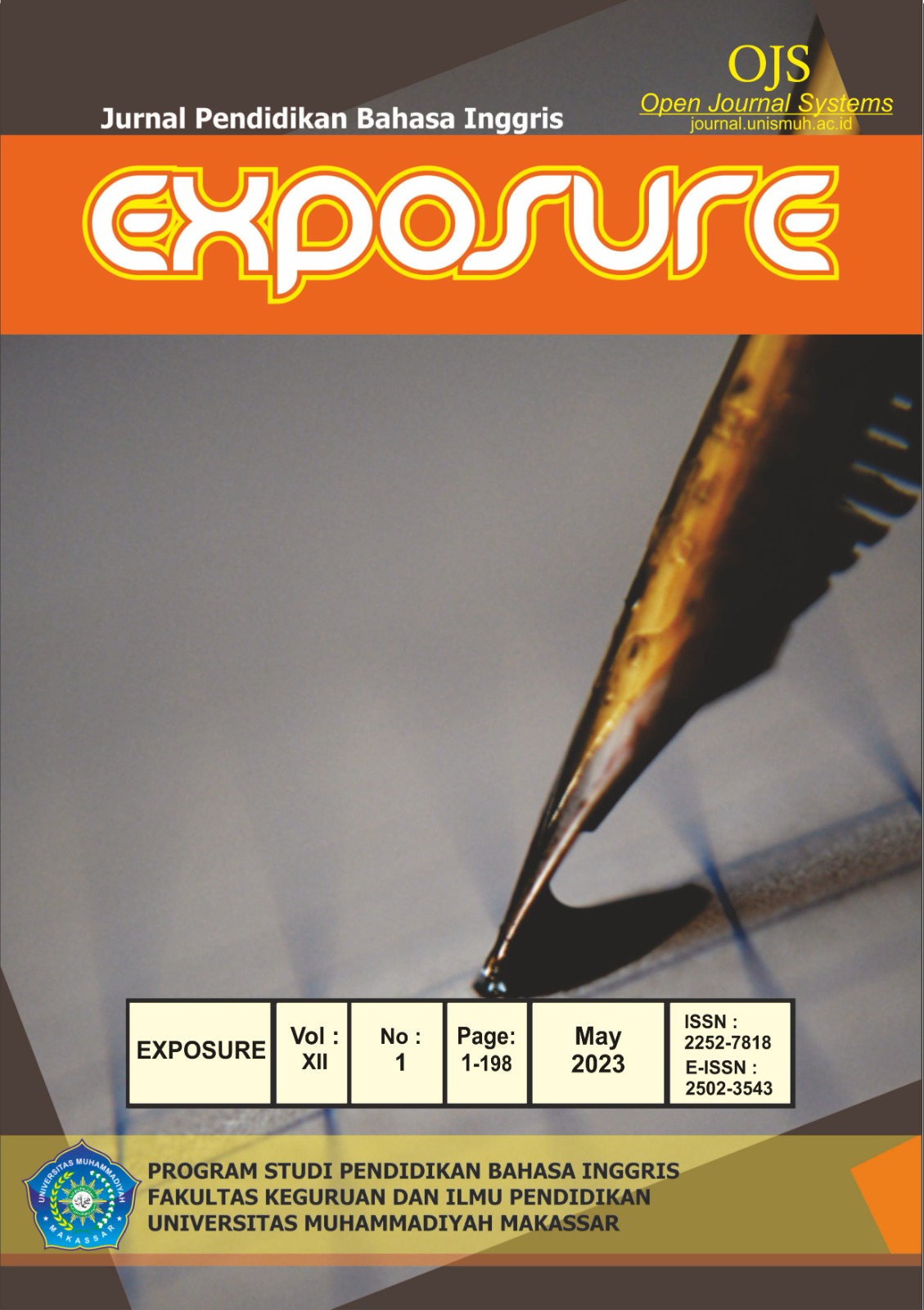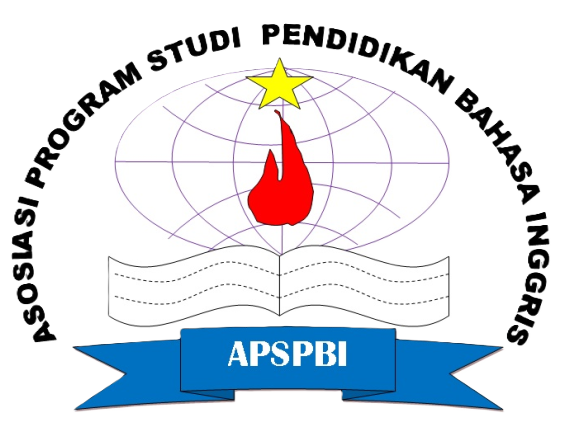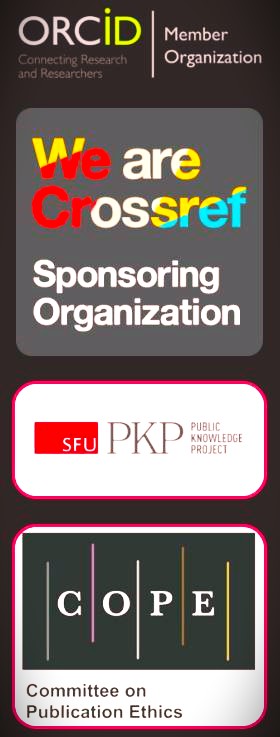STUDENTS’ PERCEPTION OF THE USE OF MOBILE ASSISTED LANGUAGE LEARNING (MALL) TO LEARN ENGLISH
DOI: https://doi.org/10.26618/exposure.v12i1.10012
MALL, Students’ Perception
Abstract
Computer Assisted Language Learning (CALL) is no longer popular among language learners due to its impractical comparison to Mobile Assisted Language Learning (MALL). MALL is a language learning tool that can assist students in expanding their learning possibilities and reshaping their language learning approach. This research aims to analyze the students’ perception of using MALL to learn English. This research was conducted using mixed methods and closed-ended questionnaires using the Likert scale of 1 to 6 to find out student perceptions of the use of MALL on the Perceived Usefulness (PU) and Perceived Ease of Use (PEoU) to gather the data. An interview was also conducted to get a more comprehensive finding. The respondent showed that they had a positive perception of the use of MALL to learn English. They agreed on the potential of MALL as a practical approach to learning English. Meanwhile, the interview session revealed that the students had drawbacks in using MALL to learn English, such as networking, technical problems on camera, and vocabulary difficulties on certain websites. Still, the students can maximize their use of it.
References
Afifah, U. N. (2020). Menerjemahkan Teks Deskripsi pada Ruang Koleksi Kasau dan Kotama dan Ruang Diorama di Museum Pusat TNI AU Dirgantara Mandala Yogyakarta. Universitas Jenderal Soedirman.
Beatty, K. (2015a). Mobile language learning: the world in our hands. Вопросы прикладной лингвистики, (17), 9–35. Некоммерческое партнерство Национальное Объединение Преподавателей ….
Beatty, K. (2015b). Language, task and situation: Authenticity in the classroom. Journal of Language and Education, 1(1), 26–45. Федеральное государственное автономное образовательное учреждение высшего ….
Biviji, R., Vest, J. R., Dixon, B. E., Cullen, T., & Harle, C. A. (2020). Factors related to user ratings and user downloads of mobile apps for maternal and infant health: cross-sectional study. JMIR mHealth and uHealth, 8(1), e15663. JMIR Publications Inc., Toronto, Canada.
Bui, H. P., Bui, H. H. P., & Dinh, P. D. (2023). Vietnamese Students’ Use of Smartphone Apps in English Learning. LEARN Journal: Language Education and Acquisition Research Network, 16(1), 28–46.
Burston, J. (2014). MALL: The pedagogical challenges. Computer Assisted Language Learning, 27(4), 344–357. Taylor & Francis.
Burston, J. (2017). MALL: Global prospects and local implementation. CALL-EJ, 18(1), 1–8.
Burston, J., & Giannakou, K. (2022). MALL language learning outcomes: A comprehensive meta-analysis 1994–2019. ReCALL, 34(2), 147–168. Cambridge University Press.
Cakmak, F. (2019). Mobile learning and mobile assisted language learning in focus. Language and Technology, 1(1), 30–48.
Creswell, J. W. (2014a). Research design : Qualitative, Quantitative, and Mixed methods approaches. SAGE Publication, Inc. (4th Editio.). SAGE Publications Ltd.
Creswell, J. W. (2014b). Qualitative, quantitative and mixed methods approaches. Sage.
Creswell, J. W., & Creswell, J. D. (2017). Research design: Qualitative, quantitative, and mixed methods approaches. Sage publications.
Gnawali, L. (2023). Culture in Language Teacher Education: A South Asian Perspective. Local Research and Glocal Perspectives in English Language Teaching: Teaching in Changing Times (pp. 47–63). Springer.
Hadi, M. S. (2020). Mobile-Assisted Language Learning (MALL) in EFL listening: An Indonesian Perspective. International Journal of Advanced Science and Technology, 29(7), 3838–3845. Science and Engineering Research Support Society.
Hassan Taj, I., Sulan, N., Sipra, M., & Ahmad, W. (2016). Impact of mobile assisted language learning (MALL) on EFL: A meta-analysis. Advances in language and literary studies, 7(2).
Hoi, V. N., & Mu, G. M. (2021). Perceived teacher support and students’ acceptance of mobile‐assisted language learning: Evidence from Vietnamese higher education context. British Journal of Educational Technology, 52(2), 879–898. Wiley Online Library.
Huang, X., Zou, D., Cheng, G., Chen, X., & Xie, H. (2023). Trends, research issues and applications of artificial intelligence in language education. Educational Technology & Society, 26(1), 112–131. JSTOR.
Jarvis, H., & Achilleos, M. (2013). From Computer Assisted Language Learning (CALL) to Mobile Assisted Language Use (MALU). Tesl-ej, 16(4), n4. ERIC.
Jeanjaroonsri, R. (2023). Thai EFL Learners’ Use and Perceptions of Mobile Technologies for Writing. LEARN Journal: Language Education and Acquisition Research Network, 16(1), 169–193.
Jegede, A., Chagga, C. A., Aimufua, G., Mazadu, J., Oloyede, A., & Olubodun, K. (2023). Mobile Privacy Awareness of Higher Education Students in Plateau State Nigeria. Jurnal Transformatika, 20(2).
Kannan, M., & Meenakshi, S. (2023). A Critical Overview of the Implementation of Language-Immersion Through the Use of Mobile Apps. Theory and Practice in Language Studies, 13(1), 186–191.
Klimova, B., Pikhart, M., Polakova, P., Cerna, M., Yayilgan, S. Y., & Shaikh, S. (2023). A Systematic Review on the Use of Emerging Technologies in Teaching English as an Applied Language at the University Level. Systems, 11(1), 42. Multidisciplinary Digital Publishing Institute.
Klimova, B., & Zamborova, K. (2020). Use of mobile applications in developing reading comprehension in second language acquisition—A review study. Education Sciences, 10(12), 391. MDPI.
Kocakoyun, S., & Bicen, H. (2017). Development and Evaluation of Educational Android Application. Cypriot Journal of Educational Sciences, 12(2), 58–68. ERIC.
Li, R. (2023). Effects of mobile-assisted language learning on EFL learners’ listening skill development. Educational Technology & Society, 26(2), 36–49.
Mahmood, A. S., Saad, N. S. M., & Nur, N. M. (2023). The Ups and Downs of Learning and Using English: Aviation Students’ Voices. International Journal of Language Instruction, 2(1), 1–15.
Major, C. H., & Savin-Baden, M. (2012). An introduction to qualitative research synthesis: Managing the information explosion in social science research. Routledge.
Merriam, S. B., & Tisdell, E. J. (2015). Qualitative research: A guide to design and implementation. John Wiley & Sons.
Nuraeni, C., Carolina, I., Supriyatna, A., Widiati, W., & Bahri, S. (2020). Mobile-Assisted Language Learning (MALL): Students’ perception and problems towards mobile learning in English language. Journal of Physics: Conference Series (Vol. 1641, p. 12027). IOP Publishing.
Oz, H. (2015). An Investigation of Preservice English Teachers’ Perceptions of Mobile Assisted Language Learning. English Language Teaching, 8(2), 22–34. ERIC.
Pal, K. (2023). Coronavirus Impact on Digital Technology Use in University Student Software Engineering Project Management. Mobile and Sensor-Based Technologies in Higher Education (pp. 232–262). IGI Global.
Raj, A., & Tomy, P. (2023). Mobile technology as a dependable alternative to language labs and to improve listening skills. International Journal of English Language and Literature Studies, 12(1), 17–32.
Rosell-Aguilar, F. (2017). State of the app: A taxonomy and framework for evaluating language learning mobile applications. CALICO journal, 34(2), 243–258. JSTOR.
Rosini, R., & Nurningsih, S. (2018). Pemanfaatan media sosial untuk pencarian dan komunikasi informasi kesehatan. Berkala Ilmu Perpustakaan dan Informasi, 14(2), 226.
Shi, Z., Luo, G., & He, L. (2017). Mobile-assisted language learning using Wechat instant messaging. International journal of emerging technologies in learning, 12(2).
Siregar, S. (2015). Metode penelitian kuantitatif: dilengkapi dengan perbandingan perhitungan manual & spss. Prenadamedia Group.
Sleeter, C. (2014). Toward Teacher Education Research That Informs Policy. Educational Researcher, 43(3), 146–153. Retrieved from http://journals.sagepub.com/doi/10.3102/0013189X14528752
Syamsiani, M., & Munfangati, R. (2023). Students’ Perception toward the Use of Tiktok Videos for Learning English. International Social Sciences and Humanities, 2(1), 324–329.
Tran, O. T. T., & Pham, V. P. H. (2023). The effects of online peer feedback on students’ writing skills during corona virus pandemic. International Journal of Instruction, 16(1), 881–896.
Wieland, N., & Kollias, L. (2020). Online Learning Before, During and After COVID-19: Observations Over 20 Years. International Journal of Advanced Corporate Learning, 13(2).
Wijayati, R. D., Nuryana, Z., Pranolo, A., & Ma’Arif, A. (2022). Higher Education Response to The COVID-19: Do Students Feel Comfortable Studying With Distance Learning? 2022 XII International Conference on Virtual Campus (JICV) (pp. 1–6). IEEE.
Wu, J. G. (2023). Mobile Assisted Language Learning Across Educational Contexts. Oxford University Press UK.
Wu, Y., & Schunn, C. D. (2023). Passive, active, and constructive engagement with peer feedback: A revised model of learning from peer feedback. Contemporary Educational Psychology, 102160. Elsevier.
Yeşilel, D. B. A. (2023). Utilizing Mobile Technology to Improve Writing Skill. New Directions in Technology for Writing Instruction (pp. 147–167). Springer.
Zain, D. S. M., & Bowles, F. A. (2021). Mobile-assisted language learning (Mall) for higher education instructional practices in efl/esl contexts: A recent review of literature. Computer Assisted Language Learning Electronic Journal, 22(1), 282–307.
Zhang, T., & Mao, Z. (2023). Exploring the development of student feedback literacy in the second language writing classroom. Assessing Writing, 55, 100697. Elsevier.
Downloads
Published
How to Cite
Issue
Section
License
Authors who publish with this journal agree to the following terms:
In order to assure the highest standards for published articles, a peer review policy is applied. In pursue of the compliance with academic standards, all parties involved in the publishing process (the authors, the editors and the editorial board and the reviewers) agree to meet the responsibilities stated below in accordance to the Journal publication ethics and malpractice statement.
Duties of Authors:
- The author(s) warrant that the submitted article is an original work, which has not been previously published, and that they have obtained an agreement from any co-author(s) prior to the manuscript’s submission;
- The author(s) should not submit articles describing essentially the same research to more than one journal;
- The authors(s) make certain that the manuscript meets the terms of the Manuscript Submission Guideline regarding appropriate academic citation and that no copyright infringement occurs;
- The authors(s) should inform the editors about any conflict of interests and report any errors they subsequently, discover in their manuscript.
Duties of Editors and the Editorial Board:
- The editors, together with the editorial board, are responsible for deciding upon the publication or rejection of the submitted manuscripts based only on their originality, significance, and relevance to the domains of the journal;
- The editors evaluate the manuscripts compliance with academic criteria, the domains of the journal and the guidelines;
- The editors must at all times respect the confidentiality of any information pertaining to the submitted manuscripts;
- The editors assign the review of each manuscript to two reviewers chosen according to their domains of expertise. The editors must take into account any conflict of interest reported by the authors and the reviewers.
- The editors must ensure that the comments and recommendations of the reviewers are sent to the author(s) in due time and that the manuscripts are returned to the editors, who take the final decision to publish them or not.
Authors are permitted and encouraged to post online a pre-publication manuscript (but not the Publisher’s final formatted PDF version of the Work) in institutional repositories or on their Websites prior to and during the submission process, as it can lead to productive exchanges, as well as earlier and greater citation of published work (see The Effect of Open Access). Any such posting made before acceptance and publication of the Work shall be updated upon publication to include a reference to the Publisher-assigned DOI (Digital Object Identifier) and a link to the online abstract for the final published Work in the Journal.














